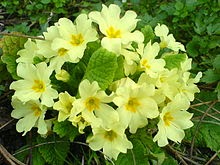The days are getting longer, and are warming up as well. We are now well into the first signs that spring has arrived - and in particular, that stalwart of the spring garden,
Primula Vulgaris, or the common primrose. Not so vulgar as it's name suggests, it is also known as the English primrose and tends to bloom with the early daffodils. It seems unnecessary to give a detailed description for such a plant, but it has a pale yellow single flower with a rosette of rather leathery leaves. It does occasionally have pink or white flowers in the wild, but the yellow form is very the the "standard" version. That it is such a staple of the spring may be seen in the derivation of it's name, which is from the medieval Latin
prima rosa, or "first rose" - even though it has little in common with the actual varieties that we now call the rose.
The common primrose used to be seen growing wild in abundance in its preferred habitat, which is open woods or shaded hedgerows, but it has been over collected (particularly in urban areas) and the swathes of primrose on banks that marked our parents' or grandparents' childhoods are sadly long gone in this part of the country - although occasionally you can see them on motorway or railway embankments where the humans have been unable to reach them, so the roads and rails are good for something at least! It is now illegal to pick the flowers from the wild, or gather the plant from there, and we should all therefore be growing this plant in our gardens as much for conservation in the South as for the pleasure it gives so early in the year. If you have a cottage style garden, it is indispensable, as it is a staple of the genre.
 |
Go on - have a dance and
surprise a chicken! |
The primrose's popularity has also lead to a large bank of folklore about the plant; did you know, for example, that the plant was supposed to have sprung from the body of Paralisos, who was turned into a primrose by his mother Flora after suffering (and possibly dying of) a broken heart? To be fair, this was so not much of an honour as it might seem, as much the same happened to Narcissus, Hyacinth, Anemone and Crocus, to name but a few. It is also supposed to be lucky to bring thirteen of the plants into the home, but unlucky to bring in only one! And, if any of you should happen to keep chickens and then see a single primrose, you must dance around the plant three times to prevent bad egg laying ... moreover, April 19th is traditionally known as Primrose Day in honour of the late Prime Minister Benjamin Disraeli, as they were his favourite flowers.
It is an easy plant to keep, preferring moist, well drained acidic soil in partial shade. It may be propagated by seed, but it will also respond well to division, which should be performed about every two to three years, between September and April. In a good year, it will keep flowering from February to May, and you will rarely need to buy another again as it will pop up readily from seed.
Please remember as well that we have a class in next month's Spring Challenge show, specifically for a posy of primroses displayed in a wine glass. A nice way of showing them is to tie the posy with some leaves surrounding the flowers, as this makes a lovely display.


No comments:
Post a Comment